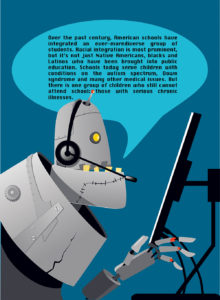By Dana Barfield
If you have children, or even if you don’t, you’ve probably heard about the scourge of bullying that is affecting today’s students in ways that seem more drastic than the bullying their parents experienced 20 years ago. For one thing, more and more often newspapers report an extreme consequence of bullying – suicide. According to the Centers of Disease Control and Prevention (CDC), suicide is the third leading cause of death among young people ages 10 to 14 and the second leading cause for ages 15 to 18. Children who are bullied are between two to nine times more likely to consider suicide. Experts in the Welds of education and psychology are seeking answers to a problem that seems to be increasing as social media provides additional bullying opportunities. Cyber bullying, bullying through digital devices and social media, is difficult to control and provides students with multiple ways to humiliate peers in an increasingly public venue.
“The problem is there is so much access through social media,” says Kimolyn Ferrell, president of Dare to Dream Young Girls Network (page 16). “It used to be bullying was just a one-on-one effort, but now that there are so many different avenues of social media, it makes it possible for a child to include so many other people in their bullying efforts.”
Spencer Amsellem was the victim of bullying that started in elementary school and continued through middle school until he turned things around in the 8th grade. Then Spencer became an activist, advocating the end of bullying in Leon County with Spencer’s Run Against Bullying. “Cyber bullying is so dangerous,” says Spencer. “People can be much braver in writing than in person. Bullies don’t understand the power of their comments or the power of their pictures. Kids being harassed on social media should immediately talk to a parent, teacher or the police.”
Knowledge is power. Simply being up to date on the latest trends in social media and technology makes it easier for parents to spot problems. Currently, Instagram, Snapchat and Facebook are the most popular among young people in Tallahassee, but new sites gain popularity quickly and can catch parents by surprise.
“These sites are fun if used correctly but can be very dangerous if the power of social media is taken advantage of,” says Spencer. “Parents need to pay close attention to their child’s behavior and ask specific questions.”
Parents shouldn’t be reluctant to follow their children on Instagram and Facebook to stay informed about their children’s interests and activities. Perhaps the most important action a parent can take, however, is to make sure their children know that they are important and special people.
Know Your Social Media
 Facebook Perhaps the most well-known social networking website, Facebook was originally created for college students in 2004 and many parents count it as their favorite form of social media. While not the heaviest users of Facebook, many tweens and teens still consider it a favorite.
Facebook Perhaps the most well-known social networking website, Facebook was originally created for college students in 2004 and many parents count it as their favorite form of social media. While not the heaviest users of Facebook, many tweens and teens still consider it a favorite.
 Instagram This mobile photo-sharing, video-sharing and social networking service allows users to share pictures and videos with other social networking platforms.
Instagram This mobile photo-sharing, video-sharing and social networking service allows users to share pictures and videos with other social networking platforms.
 Snapchat A mobile photo and video-sharing service that allows “snaps” to be viewed by friends for up to 10 seconds before they disappear.
Snapchat A mobile photo and video-sharing service that allows “snaps” to be viewed by friends for up to 10 seconds before they disappear.
 YouTube The popular video sharing website. Users can create their own channel and allow or disable comments.
YouTube The popular video sharing website. Users can create their own channel and allow or disable comments.
 Twitter Social networking service that allows users to send short 140-character messages in real time, readable by registered and unregistered users.
Twitter Social networking service that allows users to send short 140-character messages in real time, readable by registered and unregistered users.
 ask.fm An unmonitored social networking site that allows users to post anonymous questions and comments to user profiles.
ask.fm An unmonitored social networking site that allows users to post anonymous questions and comments to user profiles.











